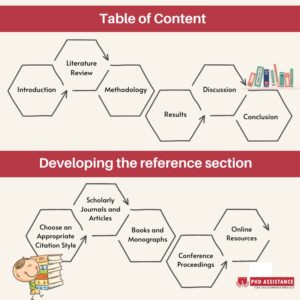How to outline a computer science dissertation from table of contents to reference section
Writing a computer science dissertation might be a difficult endeavor. Creating an excellent outline is a critical stage in the process since it aids in organizing thoughts and information into a logical conceptual framework. This blog will go over how to make an excellent outline for a computer science dissertation. The outline acts as the dissertation’s basis and guides the writing process. It should include all relevant research, references, background information, and significant points. Scholars will be better equipped to construct their dissertations with confidence and clarity if they create an ordered and well-structured outline.
- Check our PhD dissertation examples to learn about how we review or edit an article for a computer science dissertation.
Introduction
Beginning the adventure of writing a computer science dissertation is both exhilarating and difficult. As you progress in your study, it becomes increasingly important to rigorously plan your dissertation, guaranteeing a logical flow of ideas and a solid academic basis. In this thorough tutorial, we will help you through the process of outlining your computer science dissertation, from constructing a well-organized table of structure to developing the substance of your references.
I. Understanding the Significance of Outlining
Before getting into the complexities of outlining, it is critical to understand the relevance of this first stage. A successful outline acts as a road map for your dissertation, giving you a clear path for your research and assisting you in staying focused throughout the writing process. It not only improves the logical flow of your thoughts, but it also makes complicated material easier to organize into a clear and digestible narrative.

II. Crafting a Detailed Table of content
A. Introduction
- Background and Context
- Provide an overview of the research problem.
- Highlight the significance of your study in the broader context of computer science.
- Research Question and Objectives
- Clearly articulate the main research question and specific objectives.
- Ensure alignment with the overall purpose of the dissertation.
B. Literature Review
- Review of Existing Literature
- Summarize relevant research in your field.
- Identify gaps in the current knowledge base.
- Theoretical Framework
- Establish the theoretical foundation for your research.
- Discuss frameworks and models that inform your study.
C. Methodology
- Research Design
- Describe the overall approach to your research (e.g., experimental, qualitative, quantitative).
- Justify your chosen methodology.
- Data Collection
- Detail the methods used to collect data.
- Discuss the tools, instruments, or technologies employed.
D. Results
- Presentation of Findings
- Provide a clear presentation of your research results.
- Use tables, graphs, and charts to enhance clarity.
- Data Analysis
- Analyze and interpret the results in the context of your research question.
- Discuss any unexpected findings.
E. Discussion
- Interpretation of Results
- Relate your findings to the existing literature.
- Explore the implications of your research.
- Limitations and Future Research
- Acknowledge any limitations in your study.
- Suggest directions for future research.
F. Conclusion
- Summary of Key Findings
- Summarize the main contributions of your research.
- Restate the significance of your findings.
III. Developing the Reference Section
A. Citation Styles
- Choose an Appropriate Citation Style
- Follow the guidelines of a widely accepted citation style (e.g., APA, MLA, IEEE).
- Ensure consistency in citation throughout your dissertation.
B. Building a Comprehensive Reference List
- Scholarly Journals and Articles
- Include relevant and recent peer-reviewed articles.
- Provide complete Reference & citation details.
- Books and Monographs
- Reference authoritative books in your field.
- Include publication details and page numbers.
- Conference Proceedings
- Cite conference papers that contribute to your research.
- Include conference details and publication dates.
- Online Resources
- Properly cite online sources, including websites and research repositories.
- Verify the credibility of online information.
Editing And Revising
It is critical to pay special attention to details while editing and rewriting a computer science dissertation. This involves reviewing drafts, understanding formatting styles, preventing plagiarism, managing time, and learning proofreading skills.
- It is critical to inspect drafts for any flaws or inconsistencies in the text.
- Formatting styles should be followed appropriately to guarantee that the paper fulfills all of the institution’s criteria.
- Plagiarism may be prevented by properly referencing sources and ensuring that all the content is edited.
- Time management is particularly important when writing a dissertation since it helps you remain on track and fulfill deadlines.
- Finally, practicing proofreading strategies such as reading aloud or having someone else read your work will assist you in identifying any errors that may have gone unnoticed.
- Writing a computer science dissertation necessitates the author’s attention to detail and devotion. You will be able to write an effective outline for your dissertation as well as complete your work with correctness and precision if you follow the methods indicated above.
Conclusion
As you navigate the intricate process of outlining your computer science dissertation, remember that a well-structured document not only showcases your research prowess but also makes it accessible to a broader audience. From the meticulous organization of your table of structure to the comprehensive content of your references, each element plays a vital role in the success of your academic endeavor. Stay focused, adhere to the outlined structure, and let your research shine through the pages of your meticulously crafted dissertation.
- Check out our study guide to learn more about the Importance of Identifying A Research Problem For A PhD Dissertation.
About PhD Assistance
Our PhD dissertation writing help guarantees that your entire PhD dissertation is confidential as our expert writers have completed successfully around 10,000 PhD thesis successfully and submitted them to students both in India and abroad. If you are unsure of what to do after selecting your dissertation topic, avail our dissertation writing services. If you have any concerns about selecting a dissertation topic or help in conducting an extensive literature search, then get help on the same from the comfort of your desk.
References
- Misra, Sanjay. “A step-by-step guide for choosing project topics and writing research papers in ICT-related disciplines.” Information and Communication Technology and Applications: Third International Conference, ICTA 2020, Minna, Nigeria, November 24–27, 2020, Revised Selected Papers 3. Springer International Publishing, 2021.
- Fagerlund, Janne, et al. “Computational thinking in programming with Scratch in primary schools: A systematic review.” Computer Applications in Engineering Education1 (2021): 12-28.
 Previous Post
Previous Post Next Post
Next Post
